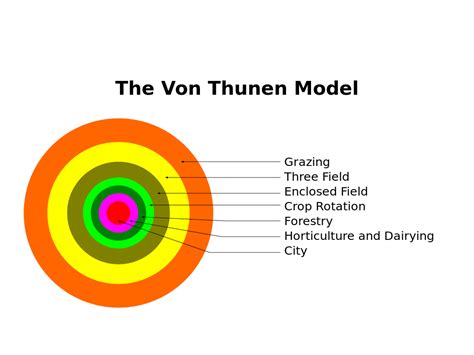Introduction
The von Thunen model is a classic model of agricultural land use that was developed by Johann Heinrich von Thunen in 1826. The model assumes a flat, uniform plain with a central market town. Farmers are located at varying distances from the market town and produce different agricultural products based on their distance from the market.

Key Principles of the Von Thunen Model
The von Thunen model is based on the following key principles:
- Land is allocated to the most profitable use. Farmers will produce the agricultural product that generates the highest profit, given their distance from the market town.
- Transportation costs are a major factor in determining land use. Farmers located closer to the market town will produce more perishable products, while farmers located further from the market town will produce less perishable products.
- Rent is determined by distance from the market town. Farmers located closer to the market town will pay higher rent for their land, as it is more valuable for agricultural production.
Zones of Agricultural Production
The von Thunen model divides agricultural land into five concentric zones around the central market town:
Zone 1: Intensive Farming
- Located within a 5-mile radius of the market town
- Produces perishable products, such as milk, vegetables, and fruits
- High land rent
Zone 2: Grain Farming
- Located between 5 and 10 miles from the market town
- Produces grains, such as wheat and corn
- Moderate land rent
Zone 3: Livestock Farming
- Located between 10 and 15 miles from the market town
- Produces meat and dairy products
- Low land rent
Zone 4: Forestry
- Located between 15 and 20 miles from the market town
- Produces timber and firewood
- Very low land rent
Zone 5: Extensive Farming
- Located more than 20 miles from the market town
- Produces low-value products, such as hay and wool
- Land is often free or very cheap
Applications of the Von Thunen Model
The von Thunen model has been used to explain agricultural land use patterns in many parts of the world. It has also been used to develop policies to promote agricultural development.
Some of the applications of the von Thunen model include:
- Planning the location of agricultural production
- Estimating the value of agricultural land
- Developing policies to support farmers
Criticisms of the Von Thunen Model
The von Thunen model has been criticized for its simplicity. It assumes that the landscape is flat and uniform, and it does not take into account factors such as climate, soil quality, and government policies.
Despite these criticisms, the von Thunen model remains a valuable tool for understanding agricultural land use patterns. It provides a framework for analyzing the factors that influence agricultural production, and it can be used to develop policies to promote agricultural development.
Tips and Tricks
Here are some tips for using the von Thunen model:
- Consider the specific context of the area you are studying. The von Thunen model is a general model, and it may not apply perfectly to all areas. Consider the specific factors that influence agricultural production in the area you are studying.
- Use the model to generate hypotheses. The von Thunen model can be used to generate hypotheses about agricultural land use patterns. Test these hypotheses using data and observation.
- Use the model to develop policies. The von Thunen model can be used to develop policies to promote agricultural development. Consider the impacts of these policies on farmers, consumers, and the environment.
Common Mistakes to Avoid
Here are some common mistakes to avoid when using the von Thunen model:
- Do not assume that the model will perfectly predict agricultural land use patterns. The von Thunen model is a general model, and it may not apply perfectly to all areas.
- Do not ignore the specific factors that influence agricultural production. The von Thunen model does not take into account factors such as climate, soil quality, and government policies. Consider these factors when using the model.
- Do not use the model to make policy decisions without considering the impacts. The von Thunen model can be used to develop policies to promote agricultural development, but it is important to consider the impacts of these policies on farmers, consumers, and the environment.
Conclusion
The von Thunen model is a classic model of agricultural land use that has been used to explain agricultural land use patterns in many parts of the world. The model is based on the principles of land allocation, transportation costs, and rent. It can be used to plan the location of agricultural production, estimate the value of agricultural land, and develop policies to support farmers.
